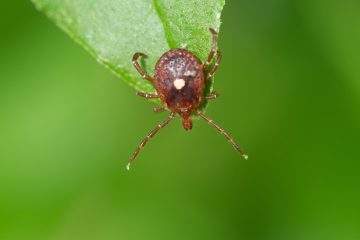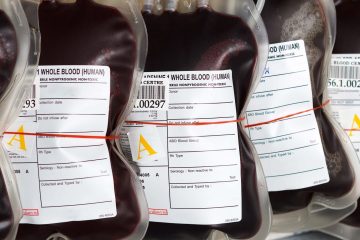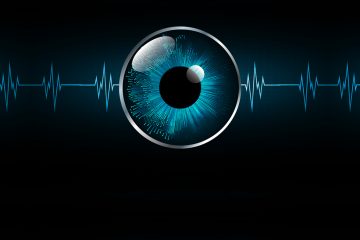Mast Cell – What To Eat When You Are Allergic To Everything What worked for this suffering teen was a diet that was gluten-free, dairy-free, low in sugar, low histamine, medium-oxalate and low in sulfite
W hat can you do when everything your child eats makes her sick? When my daughter was in the throes of mast cell activation syndrome (MCAS), virtually anything she put in her mouth triggered a serious allergic reaction. However, with the help of an excellent medical team and my daughter’s determination to succeed, we found a path to healing. I’m sharing what we did in hopes that it can help others in the same boat.
Calming the immune system
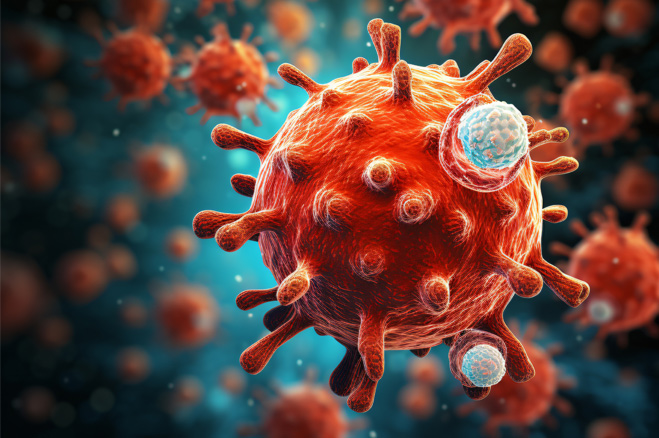 When trying to calm mast cells, the key is to reduce the number of flares. Eliminating triggers, lowering histamine levels, and getting on the right diet and the right medication(s) are critical. Every time you have an allergic reaction, it reactivates the mast cells. This domino effect makes the body more sensitive to even minor triggers. The more you can lower your histamine levels and the longer you can go without an allergic-type reaction, the calmer the immune system becomes. In our experience, if you can go three months without a reaction, you are on the road to healing.
When trying to calm mast cells, the key is to reduce the number of flares. Eliminating triggers, lowering histamine levels, and getting on the right diet and the right medication(s) are critical. Every time you have an allergic reaction, it reactivates the mast cells. This domino effect makes the body more sensitive to even minor triggers. The more you can lower your histamine levels and the longer you can go without an allergic-type reaction, the calmer the immune system becomes. In our experience, if you can go three months without a reaction, you are on the road to healing.
Here’s how my daughter got past her extreme food sensitivities.
Food Crisis 101
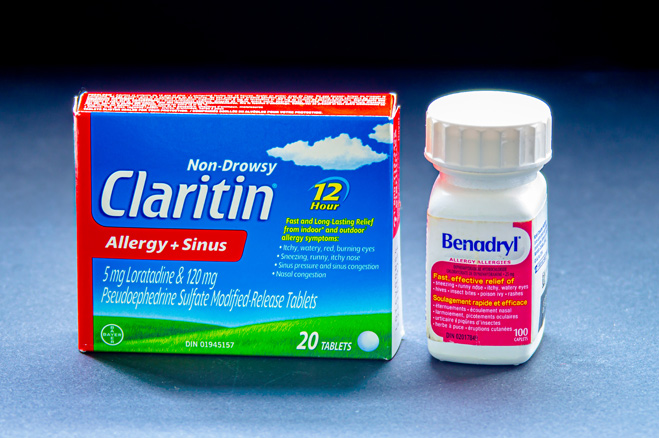 At the beginning of this MCAS journey, our routine was very stringent. Once we found the right combination of antihistamines, and she went three months without an allergic reaction, we found we could relax a little.
At the beginning of this MCAS journey, our routine was very stringent. Once we found the right combination of antihistamines, and she went three months without an allergic reaction, we found we could relax a little.
In my daughter’s case, the foods we chose were specific for her genetics and their high nutritional value. Her diet is also gluten-free, dairy-free, low in sugar, low-histamine, medium-oxalate, and low in sulfites. Depending on your specific needs, you may not need to eliminate all of the above ingredients, or you may need to eliminate these plus others —like foods high in salicylate, a chemical found naturally in certain foods.
The key for us was to make everything from fresh, wholesome, organic ingredients and fresh frozen organic meats. For example, buy organic chicken, cut and freeze in serving size packets. (I do one week’s worth at a time).
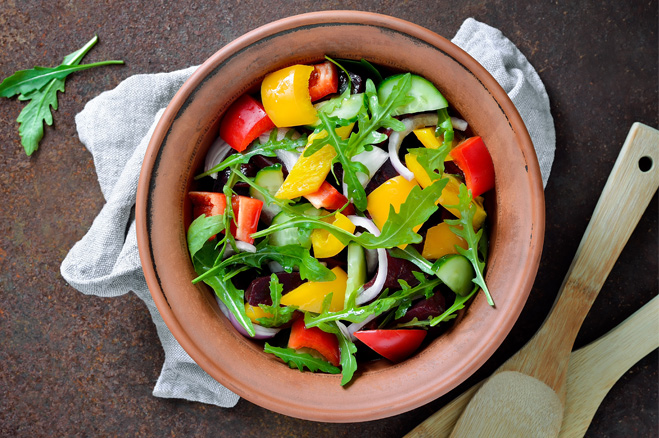 During her crisis, we went with frequent small meals. Because the act of chewing and digesting requires histamine, smaller meals were less triggering. We also eliminated all leftovers, because “aged” foods are higher in bacteria, higher in histamine and will trigger more mast cell reactions. As things improved, I cooked two meals at a time. She’d eat one immediately, I’d refrigerate the other in a glass container (no plastics), and she’d eat the next meal within 3-5 hours. (This allowed me to get other things done.) We also made sure each meal contained one protein, one carbohydrate and at least one fruit or vegetable which we rotated.
During her crisis, we went with frequent small meals. Because the act of chewing and digesting requires histamine, smaller meals were less triggering. We also eliminated all leftovers, because “aged” foods are higher in bacteria, higher in histamine and will trigger more mast cell reactions. As things improved, I cooked two meals at a time. She’d eat one immediately, I’d refrigerate the other in a glass container (no plastics), and she’d eat the next meal within 3-5 hours. (This allowed me to get other things done.) We also made sure each meal contained one protein, one carbohydrate and at least one fruit or vegetable which we rotated.
The following are a few suggestions of low-histamine foods that we rotated every three to four days during my daughter’s food crisis. Keep in mind if you are adding new foods the name of the game is low-and-slow.
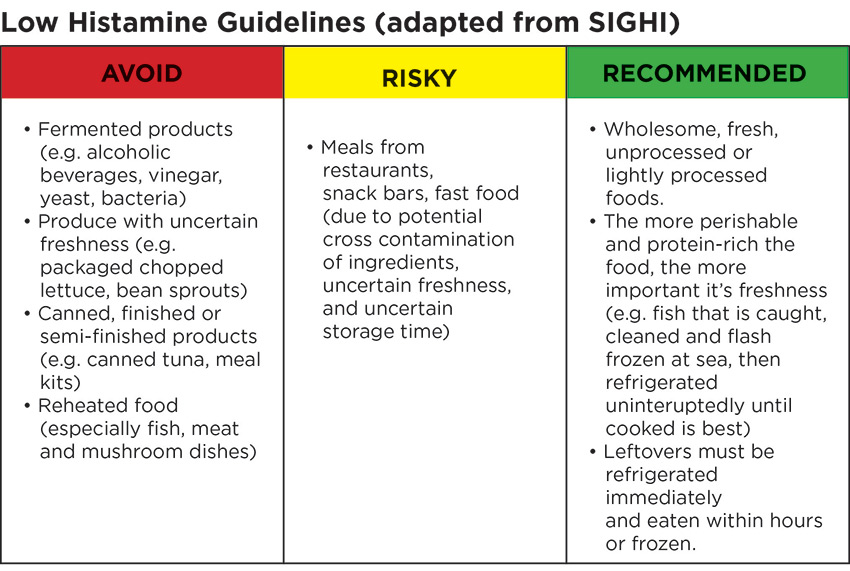
This is what worked for us:
Reduce or eliminate mast cell triggers (common triggers)
- Infection (bacteria, fungi, parasite, virus)
- Insect bites (spiders, ticks, fleas, mosquitos, bed bugs)
- Stress (heat/cold, weather changes, fatigue, emotional stimuli)
- Foods (dairy, high histamine foods, fermented or aged foods, wheat, shellfish, sugar, certain preservatives)
- Drugs (alcohol, opioids, aspirin, NSAIDS, excipients, other medications)
- Dyes (food coloring, radiographic dyes, pigments in makeup)
- Environmental toxins (pollen, dust, mold, animal dander, heavy metals, pesticides)
- Noxious odors (perfumes, smoke, exhaust fumes, smog)
This is what worked for us:
- Gluten-free oatmeal, quinoa, or white rice with a dash of coconut milk or coconut oil
- Apple, blueberry, nectarine, or peach (baked is easier for her to tolerate)
- Sautéed meat in extra virgin olive oil (EVOO) with seasonings
- Gluten-free brown rice noodles or quinoa noodles
- Boiled carrots, cauliflower, broccoli, or peas (I throw them in with the noodles)
- Baked pumpkin or sunflower seeds (soak 6-8 hours, rinse, bake in EVOO at 300 degrees for 15-25 minutes, until done)
- Baked meat, coated in EVOO* and seasonings**
- Baked butternut, acorn, or summer squash; sweet potato (the white one)
- Sautéed arugula, asparagus, butter lettuce, or watercress
*I use our homegrown certified 100% extra virgin olive oil to sauté or bake everything (beware of fake EVOO that may contain mast cell triggers). If you are salicylate-intolerant, you may have trouble with EVOO. Coconut oil and nigella sativa oil (black seed oil) are also recommended.
**Seasonings: Sea salt, pink pepper, ginger, chives, garlic (small amounts), basil, parsley, thyme, rosemary, and sage (dehydrated herbs are more tolerable when in a crisis.)
Note: I am not a doctor. Food allergies are unique to each individual, so it’s important that you work closely with your doctor or a registered dietitian to find and eliminate your food triggers and then design a balanced plan that works for you.
Resources:
- SIGHI-Leaflet Histamine Elimination Diet Simplified histamine elimination diet for histamine intolerance (DAO degradation disorder). http://www.histaminintoleranz.ch/downloads/SIGHI-Leaflet_HistamineEliminationDiet.pdf
- Swiss Interest Group Histamine Intolerance (SIGHI) Food Compatibility List. https://www.mastzellaktivierung.info/downloads/foodlist/21_FoodList_EN_alphabetic_withCateg.pdf
- MastCell360 Low Histamine Foods List for MCAS and Histamine Intolerance. https://mastcell360.com/low-histamine-foods-list/
Editor’s note: Any medical information included is based on a personal experience. For questions or concerns regarding health, please consult a doctor or medical professional.


























